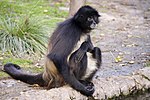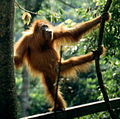 | Brachiation (from "brachium", Latin for "arm"), or arm swinging, is a form of arboreal locomotion in which primates swing from tree limb to tree limb... 12 KB (1,419 words) - 19:47, 2 December 2023 |
 | Arboreal locomotion (section Brachiation) In some areas trees are close together and can be crossed by simple brachiation. In other areas, trees are not close together and animals need to have... 20 KB (2,377 words) - 20:56, 31 March 2024 |
 | muscles of the rotator cuff in apes like the orangutan, which engage in brachiation and possess the muscle mass needed to support the body weight by the... 16 KB (1,728 words) - 04:31, 18 April 2024 |
Suspensory behavior (section Brachiation) avoiding predators. Different types of suspensory behaviour include brachiation, climbing, and bridging. These mechanisms allow larger species to distribute... 18 KB (2,202 words) - 17:29, 16 December 2023 |
branch, through a process called brachiation. Their arms are longer than their legs, and are much more powerful. Brachiation was traditionally used to explain... 3 KB (338 words) - 14:45, 24 January 2024 |
 | gibbon lives in primary tropical forest, foraging for fruits, using brachiation to move through the trees. Little is known about this species in the... 6 KB (577 words) - 12:01, 5 April 2024 |
 | golden-hair monkey (金丝狨) and a number of pet gibbons, whose graceful brachiation he admired. An elegy written by him upon the death of one of his gibbons... 2 KB (298 words) - 15:29, 20 October 2023 |
 | include leaping from tree to tree and swinging between branches of trees (brachiation); terrestrial locomotion techniques include walking on two hindlimbs... 158 KB (16,280 words) - 12:02, 2 May 2024 |
 | variant of the monkey bars Jungle Jim (disambiguation) Outdoor playset Brachiation Hinton's original patents for the "climbing structure" are U.S. patent... 6 KB (738 words) - 15:35, 28 March 2024 |
 | arboreal, climbing trees skilfully and brachiating through the forests. Brachiation is possible because of its mobile wrist joints, full rotation of the... 7 KB (785 words) - 09:32, 6 April 2024 |
 | dinosaur's back and forelimb muscles. Chimpanzees are far better at brachiation than humans. Their clavicles possess a cranially oriented twist on the... 15 KB (1,814 words) - 19:49, 29 June 2023 |
 | arboreal creatures and are specialists of swinging from tree to tree (brachiation), they are also terrestrial when foraging. White-faced sakis typically... 10 KB (1,269 words) - 18:06, 6 April 2024 |
 | the gibbon is specialized for arboreal movement, travelling rapidly by brachiation (see below). Others living on rock faces such as in mountains move on... 79 KB (8,918 words) - 05:25, 30 April 2024 |
 | of the arms, which were shortened through the removal of the need for brachiation. Another change is the shape of the big toe. Recent studies suggest that... 253 KB (26,320 words) - 15:45, 3 May 2024 |
Snake-arm robot, Roboboa, and Snakebot. See Autonomous underwater vehicles Brachiation allows robots to travel by swinging, using energy only to grab and release... 27 KB (3,576 words) - 15:00, 13 March 2024 |
 | a vestigial thumb, an adaptation which enables them to travel using brachiation. Peruvian spider monkeys live in groups of 20–30 individuals, but these... 13 KB (1,632 words) - 17:51, 6 April 2024 |
 | "quadrupedal walking, climbing, leaping, semi-brachiation (tree-swinging) and occasional full brachiation." It feeds on a variety of young leaves, leaf... 11 KB (1,123 words) - 15:56, 31 January 2023 |
 | dorsally placed scapula to allow for increased mobility involved in brachiation. Their prehensile tail with a hairless gripping pad at the end also allows... 13 KB (1,514 words) - 18:05, 6 April 2024 |
animals move, and learning more about them, he wanted to emulate the brachiation of the animals. Bohatsch made a prototype in 2018 together with co-founder... 15 KB (1,548 words) - 21:32, 20 March 2024 |











